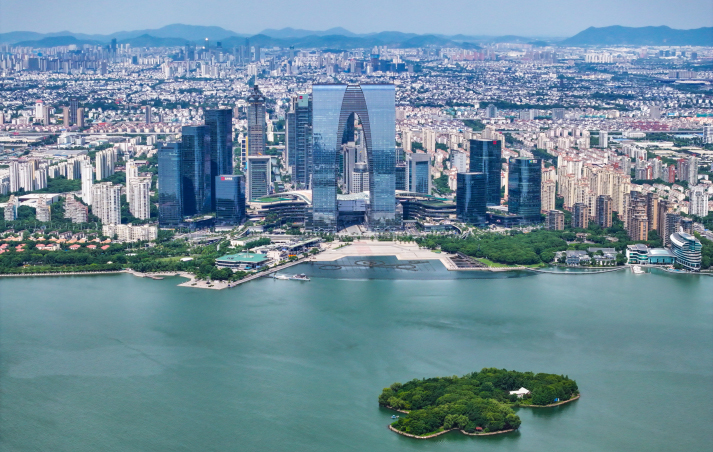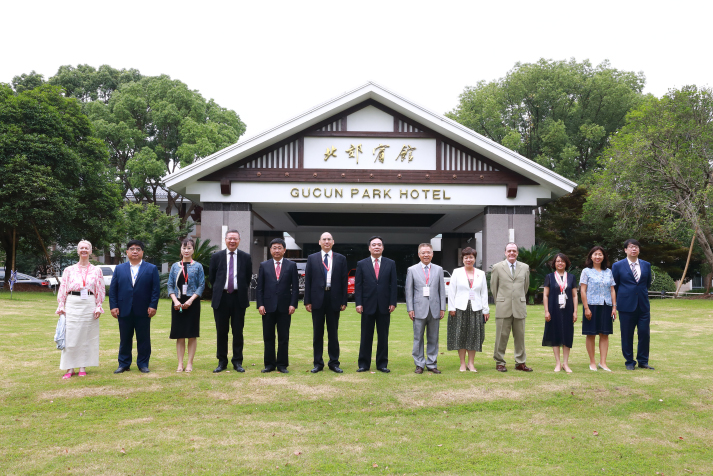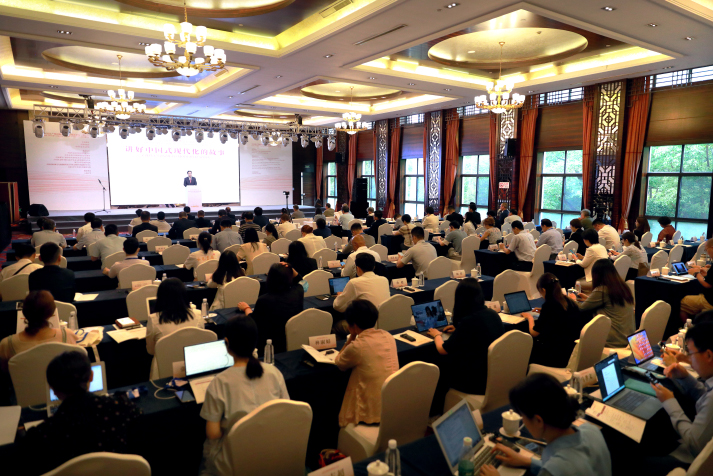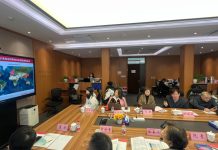
What is Chinese modernization? Does Chinese modernization equal “China first?” Questions like these have frequently popped up abroad since the concept was first introduced at the 20th National Congress of the Communist Party of China (CPC) in October 2022.
“The CPC has upheld mutual learning among civilizations and driven Chinese modernization to benefit nations around the world. China is promoting Chinese modernization neither for ‘self-admiration’ nor to ‘put China first.’ Instead, it hopes to bring more new opportunities to global development in the process of achieving its own growth,” Lu Cairong, Vice President of China International Communications Group (CICG), said at the CPC International Image Innovation Forum in Shanghai on July 6. Themed The Path to China’s Modernization, the forum discussed the topic of how to better explain the story of the CPC-led Chinese modernization to the global community.
Jointly hosted by CICG and the Central Institute of Socialism, the event gathered around 200 experts and scholars from government institutions, universities, media outlets and think tanks to elaborate on the narrative of China’s path to modernization.
Transformation
But first, what is Chinese modernization? The political report to the 20th CPC National Congress, shedding light on China’s policy priorities in the next five years and beyond, stressed that essential requirements of Chinese modernization are: upholding the leadership of the CPC and socialism with Chinese characteristics, pursuing high-quality development, developing whole-process people’s democracy, enriching the people’s cultural lives, achieving common prosperity for all, promoting harmony between humanity and nature, building a human community with a shared future, and creating a new form of human advancement.
To achieve Chinese modernization, the CPC must rely on the people, respect the people’s creativity and collect the knowledge and strength of all, Lu said. The Party is continuously honing the concept of whole-process people’s democracy to ensure the Chinese public can participate, in different ways and on different levels, in the management of state, economic, cultural and social affairs in accordance with the law.
“The CPC pays great attention to the spirit of ‘helping others succeed while seeking our own success’ in advancing Chinese modernization, and achieving this modernization will provide new opportunities for, as well as inject positive energy into, world development,” Lu emphasized in his forum address.
Zhao Qizheng, former Minister of the Information Office of the State Council, China’s cabinet, used the development of Shanghai as an example to explain Chinese modernization. The main purpose of developing Shanghai’s Pudong New Area in the 1990s was to revitalize the megacity and transform it into a hub like London, New York City, Tokyo and Singapore. Formerly acres of farmland, Pudong today has been turned into one of the world’s busiest areas, flourishing in the fields of global trade and finance, and boasting some of the world’s highest skyscrapers.
“Chinese modernization is socialist modernization under the leadership of the CPC,” Zhao pointed out. “China is very big and characterized by significant regional disparities in development conditions such as climate, resources, as well as industrial and scientific and technological foundations. The development of the country’s different parts cannot and does not feature the same pattern, but all are developed under the Party’s coordination.”

Manifestation
Chinese modernization is the modernization of a huge population, of common prosperity for all, of material and cultural-ethical advancement, of harmony between humanity and nature, and of peaceful development, according to the report to the 20th CPC National Congress. Xu Shaogang, Academic Dean of the Central Institute of Socialism, stated that the process, especially its features unique to the Chinese context, inspires other nations to seek their own development paths and encourages the world to pursue a shared, brighter future.
“Chinese modernization has dispelled the myth that ‘modernization equals Westernization,’ created a new model for human advancement and provided new options for other developing countries to draw from as they pursue modernization through independent development,” Xu said.
The Chinese approach has abandoned the traditional modernization model. The latter is capital-centered, often polarizes rich and poor, pursues only material growth, and sacrifices resources and the environment to achieve its goals, according to Xu.
Chinese modernization upholds the philosophy of people-centered development, the concept of harmony between humanity and nature, and a vision of global governance featuring extensive consultation, joint contributions and shared benefits, Xu continued.
Hu Zhaoming, Director General of the Bureau of Public Information and Communication under the CPC Central Committee International Department, pointed out that stepping up international promotion of the Party’s image is imperative.
“The international promotion of the CPC’s image used to face ‘invisible obstacles’ created by a Western-dominated international discourse,” Hu said. “Today, these invisible obstacles have turned into ‘a tangible iron wall,’ a fact unprecedented since China’s reform and opening up first began [in 1978].”
While pointing out how the creation of China’s own narrative is key to breaking down said “wall,” Hu added, “Chinese modernization is a prime example of the CPC’s major theoretical innovation. It demonstrates a new path toward modernization.”
Inspiration
Jusuf Wanandi, co-founder and Vice Chairman of the Board of Trustees of the Center for Strategic and International Studies (Indonesia), said the China-proposed Global Development Initiative, advocating common development and progress with great quality, Global Security Initiative, improving the world’s diplomatic and security architecture, and Global Civilizations Initiative, promoting humanity’s shared values, are all noble in spirit.
“Peace and development are important elements in China’s proposal to build a community with a shared future for humanity,” he said. “China’s development will deliver great opportunities for all.”
Vladimir Norov, former Secretary General of the Shanghai Cooperation Organization, said in his forum address that the fundamental principles of the Chinese modernization model, such as prioritizing public interests, strategic planning and the use of market competition mechanisms, can be considered and adopted by other countries according to their individual conditions and needs.
Norov further expressed his belief that the Chinese path toward modernization can inspire other countries, especially developing countries that face a range of challenges and crises in their development, allowing them to learn from China’s experiences and apply that knowledge to their own development efforts.
Li Fang, Deputy Editor in Chief of the online English edition of the People’s Daily, China’s most widely circulated newspaper, said China’s modernization and peaceful development have made “irreplaceable contributions to the world.”
China, together with other emerging economies, has initiated new types of development institutions and cooperation mechanisms, which effectively supplemented the established global cooperation model. These modes of cooperation have effectively supplemented the deficiencies of existing global governance mechanisms, he said.

Communication
As Chinese modernization is a new concept, it is important to accurately and comprehensively introduce it to the international community.
“To tell the story of Chinese modernization the right way, it is necessary to understand its theoretical and practical connotations, and grasp its open and inclusive nature,” Xu stressed.
Zhang Weiwei, Director of the China Institute at Shanghai’s Fudan University, said the real and vivid stories of the CPC and Chinese modernization are “abundant.”
“China has world-class highways, first-class high-speed railroads and first-class digital infrastructure; mobile payment is available in any urban or rural area in the country; and online videos can be watched in mountainous areas and remote villages. These are some of China’s most tangible success stories,” Zhang said.
David Ferguson, a recipient of the Chinese Government Friendship Award and Honorary English Editor in Chief with the Foreign Languages Press under CICG, said China’s modernization features “a perfect structure plus process and is based on a series of actions compatible with the world today as well as China’s national conditions.” Ferguson believes it is important to deeply understand as well as discuss China’s modernization path.
“Despite their different histories, cultures and national conditions, people everywhere all have the right to pursue and explore the realization of humanity’s common values. This is what we should follow in telling the story of Chinese modernization,” Li said in his forum address.
During the event’s parallel sessions, participants exchanged their views on topics including the interpretation of the CPC’s implementation of whole-process people’s democracy, how to better present the Global Civilizations Initiative, the CPC’s international communication to promote the harmonious coexistence between humanity and nature, as well as raising international recognition of the Party’s role in boosting world peace and development.
The forum also launched the CPC International Image Communication Innovation Joint Research Program. Proposed by the China Center for International Communication Development under CICG, this program aims to facilitate exchanges of information, resources and research findings by gathering the latest outcomes in theoretical research from different institutions such as government departments, universities, media outlets and think tanks. –The Daily Mail-Beijing Review news exchange item





